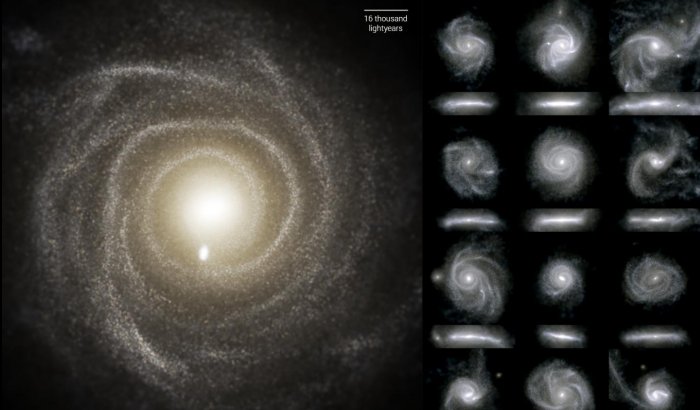Large-Scale Simulation Used As Time Machine: Galactic Fountains And Carousels
Eddie Gonzales Jr. – MessageToEagle.com – Most detailed large-scale cosmological simulation of the evolution of galaxies yet, has been announced by scientists from Germany and the United States.
It allows study in detail how galaxies form, and how they have evolved since shortly after the Big Bang, and reveals the geometry of the cosmic gas flows around galaxies determines galaxies’ structures and vice versa.
 Images of the optical light emitted by the stars of 16 galaxies from the TNG50 simulation. Each galaxy is seen face-on or from the top (top sub-panels), and edge-on or from the side (lower sub-panels). Credit: D. Nelson (MPA) and the IllustrisTNG team
Images of the optical light emitted by the stars of 16 galaxies from the TNG50 simulation. Each galaxy is seen face-on or from the top (top sub-panels), and edge-on or from the side (lower sub-panels). Credit: D. Nelson (MPA) and the IllustrisTNG team
For the first time, the TNG50 simulation combines the idea of a large-scale cosmological simulation — a Universe in a box — with the computational resolution of “zoom” simulations, at a level of detail that had previously only been possible for studies of individual galaxies.
In a simulated cube of space that is more than 230 million light-years across, TNG50 can discern physical phenomena that occur on scales one million times smaller, tracing the simultaneous evolution of thousands of galaxies over 13.8 billion years of cosmic history.
It does so with more than 20 billion particles representing dark (invisible) matter, stars, cosmic gas, magnetic fields, and supermassive black holes. The calculation itself required 16,000 cores on the Hazel Hen supercomputer in Stuttgart, working together, 24/7, for more than a year — the equivalent of fifteen thousand years on a single processor, making it one of the most demanding astrophysical computations to date.
“Numerical experiments of this kind are particularly successful when you get out more than you put in. In our simulation, we see phenomena that had not been programmed explicitly into the simulation code,” Dr Dylan Nelson from Max Planck Institute for Astrophysics, Garching, said in a press release.
“These phenomena emerge in a natural fashion, from the complex interplay of the basic physical ingredients of our model universe.”
TNG50 features two prominent examples of this kind of emergent behavior. The first concerns the formation of “disc” galaxies like our own Milky Way. Using the simulation as a time machine to rewind the evolution of cosmic structure, researchers have seen how the well-ordered, rapidly rotating disc galaxies emerge from chaotic, disorganized, and highly turbulent clouds of gas at earlier epochs.
“In practice, TNG50 shows that our own Milky Way galaxy with its thin disc is at the height of galaxy fashion: over the past 10 billion years, at least those galaxies that are still forming new stars have become more and more disc-like, and their chaotic internal motions have decreased considerably. The Universe was much messier when it was just a few billion years old!” Dr Annalisa Pillepich (Max Planck Institute for Astronomy, Heidelberg) said.
As these galaxies flatten out, researchers found another emergent phenomenon, involving the high-speed outflows and winds of gas flowing out of galaxies.
This launched as a result of the explosions of massive stars (supernovae) and activity from supermassive black holes found at the heart of galaxies.
Written by Eddie Gonzales Jr. – MessageToEagle.com Staff










